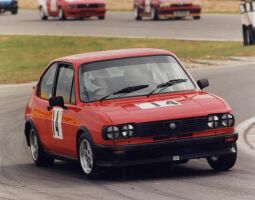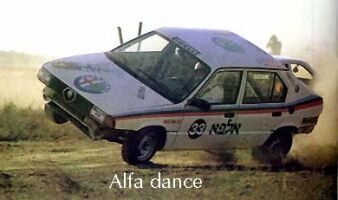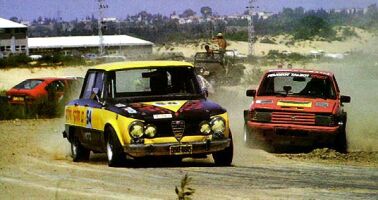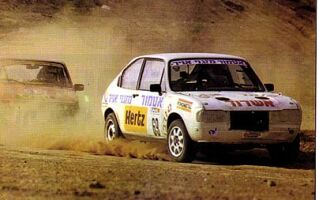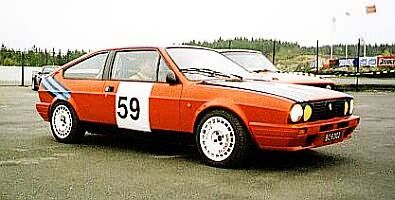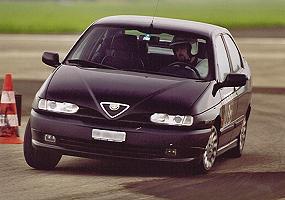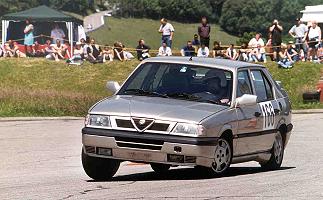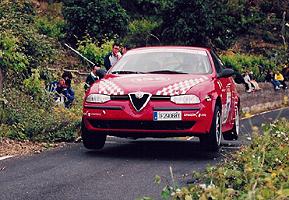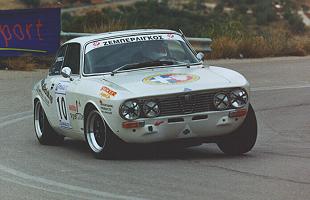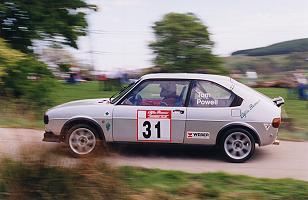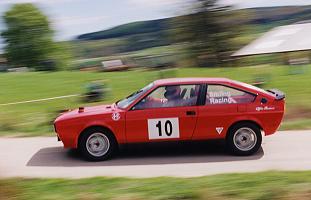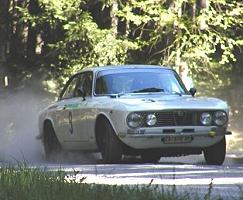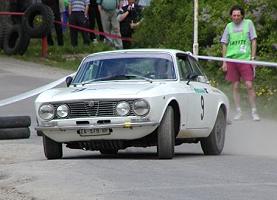Alfa
Romeo made its first tentative steps in motorsport in 1911 when it entered
the Targa Florio with two 20/30s. Neither finished and nor did the single
example entered in 1913. In that latter year, however, a better result
was achieved in the Parma-Poggio di Berceto hillclimb with a 40/60 and
the following year saw 4.5-litre 40/60s finish second and third in the
Coppa Florio.
1914 also saw Alfa developing its first
Grand Prix car. This used a new 4.5-litre engine designed by Merosi featuring
two overhead camshafts and four valves per cylinder, which generated 88bhp
@ 2950rpm. It was fitted to a stretched and modified 40/60 chassis (up
from 2950mm to 3000mm).
After the war Alfa returned to competition,
the first successes coming in 1920 in both hillclimbs and circuit racing
using 20/30s, 40/60s and the 1914 GP car, the drivers were Campari, Ascari,
Sivocci and a young Enzo Ferrari. A similar line-up competed in various
events in 1921, with varying success, the most impressive result being
an Alfa Romeo one-two-three at Mugello in July of that year. 1922 saw principally
the same equipment and drivers in use and the successes were fewer, but
a new car was under development.
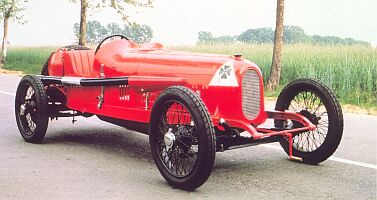 The
RL Targa Florio was again designed by Merosi and in 1923 it came first
and second (driven by Sivocci and Ascari respectively) in the event from
which it took its name. The same year also saw the emergence of the new
P1 2-litre GP car. Also designed by Merosi just in time for the Italian
GP at Monza in September, a tragic accident in practice killed Sivocci
and caused the rest of the cars to be withdrawn. It never competed again.
The
RL Targa Florio was again designed by Merosi and in 1923 it came first
and second (driven by Sivocci and Ascari respectively) in the event from
which it took its name. The same year also saw the emergence of the new
P1 2-litre GP car. Also designed by Merosi just in time for the Italian
GP at Monza in September, a tragic accident in practice killed Sivocci
and caused the rest of the cars to be withdrawn. It never competed again.
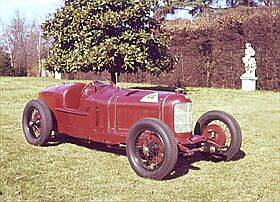 For
the 1924 season the new star at Alfa Romeo, Vittorio Jano from Fiat, designed
the all new P2. The engine was a supercharged 1987cc straight-eight, which
in 1924 produced 140bhp. By 1925 this went up to 155bhp whilst for the
1930 season the capacity was increased to 2007cc (by increasing the bore
slightly) and the power climbed to 175bhp. Three bodywork styles were used,
all two seaters. The original had a cowled radiator and boat-tail, two
of which were later modified by having the tail cut off and replaced by
a shallow angle spare wheel carrier. For the 1930 season three boat-tailed
cars were modified to use a plated radiator similar to the Gran Sport 1750 road car.
For
the 1924 season the new star at Alfa Romeo, Vittorio Jano from Fiat, designed
the all new P2. The engine was a supercharged 1987cc straight-eight, which
in 1924 produced 140bhp. By 1925 this went up to 155bhp whilst for the
1930 season the capacity was increased to 2007cc (by increasing the bore
slightly) and the power climbed to 175bhp. Three bodywork styles were used,
all two seaters. The original had a cowled radiator and boat-tail, two
of which were later modified by having the tail cut off and replaced by
a shallow angle spare wheel carrier. For the 1930 season three boat-tailed
cars were modified to use a plated radiator similar to the Gran Sport 1750 road car.
Returning to its debut year of 1924, the
P2 began with victories in several races, including the European GP (at
Lyons) and the Italian GP (at Monza). 1925 saw Alfa Romeo win the inaugural
World Championship with the P2, although this was offset by the tragic
death of Ascari whilst leading the French GP. Victories that year included
the European GP (at Spa) and the Italian GP (at Monza).
Sporting versions of the new road cars
continued to bring Alfa Romeo victories, including the 1928 (Campari in
a 1500SS), 1929 (1750) and 1930 (1-2-3 for 1750s) Mille Miglias. The Targa
Florio in the latter year was won by the brought-back-to-the-factory P2
driven by Varzi, not its only success that year.
For 1931 Jano developed a new car, the
8C2300. This used a supercharged dohc engine displacing 2336cc, which generated
142bhp. Although unsuccessful in its debut event, the Mille Miglia, Nuvolari
won the Targa Florio in May, which was followed by victory at Le Mans (driven
by Earl Howe & HRS Birkin). This success was repeated for the following three years.
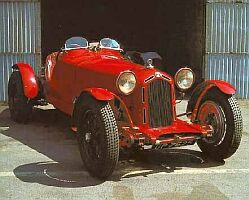 Back
to 1931 again, and for the GP season Alfa developed two cars, a ‘conventional’
car using the 8C2300 engine and the Tipo A which used two 6C1750 engines
side-by-side. Following its victory in the Italian GP at Monza, the 2300
GP cars were known as he ‘Monza’. These went on to score numerous victories
over the next two years, most famously the 1932 and 1933 Targa Florio’s and the 1934 Mille Miglia.
Back
to 1931 again, and for the GP season Alfa developed two cars, a ‘conventional’
car using the 8C2300 engine and the Tipo A which used two 6C1750 engines
side-by-side. Following its victory in the Italian GP at Monza, the 2300
GP cars were known as he ‘Monza’. These went on to score numerous victories
over the next two years, most famously the 1932 and 1933 Targa Florio’s and the 1934 Mille Miglia.
For the 1932 season the Tipo B was developed.
A new single-seat design, it used a 2300 engine expanded to 2654cc. Nuvolari
drove it to victory in its debut event, the Italian GP at Monza, after
which it became known as the P3. It went on to win the French and 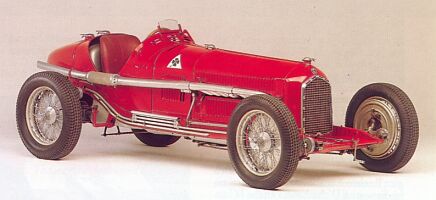 German
GPs and numerous other events that year. Unfortunately by this time Alfa
Romeo was in financial difficulties and withdrew from racing for 1933.
Unofficially entered cars still won the Mille Miglia and Le Mans, amongst others.
German
GPs and numerous other events that year. Unfortunately by this time Alfa
Romeo was in financial difficulties and withdrew from racing for 1933.
Unofficially entered cars still won the Mille Miglia and Le Mans, amongst others.
1934 saw the return of the factory team
with the P3s now sporting a 2902cc engine. Victory at Monaco (the season
opener) was followed by many others including the Bordino GP, the Tripoli
GP and the Mille Miglia. The same car had its engine further expanded to
3165cc for 1935 as well as receiving modified suspension and scored numerous
victories including the Nice GP (one-two-three), the Marne GP (one-two-three),
the Turin GP (one-two-three), the Pau GP (one-two), the Dieppe GP (one-two)
and the Targa Florio (one-two). The new GP car, the 8C35 debuted that year
and also scored a victory at the Circuit of Modena. The new Type C chassis
could accommodate either the new 3.8-litre straight 8 or a 60deg V12 of just over 4-litres.
Worth mentioning in 1935 is also the ‘Bimotore’
which wed either two 2.9-litre or two 3.2-litre engines, one ahead of and one behind the driver.
1936 saw both 8 and 12 cylinder Tipo C
cars in action and scoring many victories, a scenario repeated in 1937
although the victories were fewer and limited to events on home soil only.
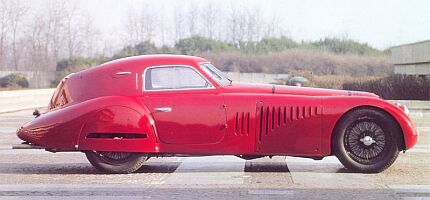 Returning
to the road, in 1936 Alfa Romeo won the Mille Miglia with 8C2900As finishing
first, second and third. More victories that year were followed by a one-two
at the Mille Miglia in 1937, this time with 6C2300B cars. The victories
continued until the following year when the first three places in the Mille
Miglia were filled with 8C2900B cars.
Returning
to the road, in 1936 Alfa Romeo won the Mille Miglia with 8C2900As finishing
first, second and third. More victories that year were followed by a one-two
at the Mille Miglia in 1937, this time with 6C2300B cars. The victories
continued until the following year when the first three places in the Mille
Miglia were filled with 8C2900B cars.
Back in GP racing in 1938, the formula
was changed to a maximum capacity of 3-litres. Alfa Romeo developed the
Tipo 308 from the 8C2900B, but little success was achieved, and so the
312, with a 2996cc engine derived from the 12C 1937 GP car, was built.
Unfortunately this car also failed to be as successful as desired. At the
same time Alfa had been developing the Tipo 158 Alfetta with a 1.5-litre
eight cylinder engine for a smaller class of racing and two of these engines
joined together to form a 16 cylinder unit mounted in a 12C-37 chassis
(together with two superchargers) created the 316, a 440bhp car which,
despite second place in the Italian GP, also proved unsuccessful.
The next cars to emerge were the Tipo 162,
with a 2995cc V16 engine developed in Britain by Ricardo, the Tipo 163
using an unsupercharged 162 engine positioned behind the driver and the
Tipo 512. The latter was a mid-engined car powered by a 1490cc flat-twelve
engine with two camshafts per cylinder bank, a two-stage supercharging
system and 335bhp. Unfortunately the war stopped development of these cars,
and although a few were built, none were raced.
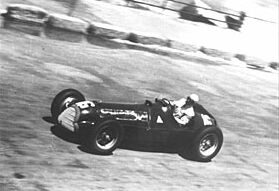 As
mentioned above, the Tipo 158 Alfetta was being developed at the same time,
for use in the Italian National Championship. This had a 1500 dohc straight-eight
engine, supercharged and producing 190bhp @ 7500rpm. It won its debut event
and continued to score victories as the power increased (up to 225bhp in
mid-1939), only to be stopped by the war.
As
mentioned above, the Tipo 158 Alfetta was being developed at the same time,
for use in the Italian National Championship. This had a 1500 dohc straight-eight
engine, supercharged and producing 190bhp @ 7500rpm. It won its debut event
and continued to score victories as the power increased (up to 225bhp in
mid-1939), only to be stopped by the war.
Racing began again in 1946, and after one
miserable race the 158s began winning again. They now had two-stage supercharging
and around 254bhp. Success continued through 1947, when a change in the
regulations made the 158 eligible for GP racing, and into 1948 by which
time the 158 had 310bhp @ 7500rpm thanks to numerous modifications. At
the end of a successful 1948 season Alfa withdrew from GP racing.
1950 saw Alfa Romeo return once again to
GP racing as well as contesting various sportscar events. The 158 now had
360bhp @ 8500rpm and won the first event of the year at San Remo. The Targa
Florio was then won by a 6C2500 Competizione Coupe, followed by a one-two-three
in the European GP, the first event of the new World Championship. Alfa
Romeo went on to win every other event in that championship in that year,
handing Farina and Alfa Romeo the inaugural World Championship. Their drivers
that year were Farina (the Champion), Fangio, Fagioli, Sanesi and Taruffi.
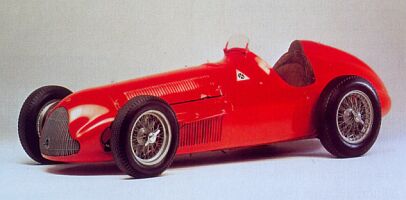 For
1951 the Tipo 159 was developed. With 425bhp Fangio won the World Championship
with Alfa Romeo taking five race victories, followed by Ferrari with three.
Alfa Romeo then decided to withdraw from GP racing and concentrate on sports
cars. This time the withdrawal would last for over 25 years.
For
1951 the Tipo 159 was developed. With 425bhp Fangio won the World Championship
with Alfa Romeo taking five race victories, followed by Ferrari with three.
Alfa Romeo then decided to withdraw from GP racing and concentrate on sports
cars. This time the withdrawal would last for over 25 years.
In the early 1950s Alfa Romeo produced
the Disco Volante, a concept car based on the 1900 mechanicals. This developed
into the 6C3000CM, a coupe with a stretched 6C2500 engine. The latter was
a 3.5-litre unit with 275bhp. Three cars were entered in the 1953 Mille
Miglia, Fangio managing second despite serious technical problems. The
same cars were used at Le Mans and various other long distance events.
In the following year Alfa built one racecar, the 6C3000PR, but this seriously
injured Sanesi, the driver, in an accident in its first race and Alfa decided that was enough.
Privateers continued to campaign Alfa Romeo’s
in various events and races throughout he 1950s and early 60s with some
support from the factory. In 1963 Zagato produced the Giulia TZ in small
numbers for private customers and Alfa Romeo became interested 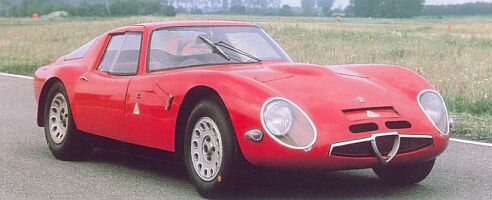 enough
to have 10 TZ2s produced in 1965 for Autodelta, the company contracted
to run the official competition cars. At the same time there appeared the
Giulia GTA and GTA corsa. Based on the Bertone designed Giulia GT the GTA
had 115bhp whilst the full-race ‘Corsa’ version had 170. 1967 saw 10 supercharged
version appear, called the GT-SA, whilst from 1968 the GTA1300, with 160bhp,
was produced. The final cars in this family were the 1750 and 2000 GTAm’s, with 220 and 240bhp respectively.
enough
to have 10 TZ2s produced in 1965 for Autodelta, the company contracted
to run the official competition cars. At the same time there appeared the
Giulia GTA and GTA corsa. Based on the Bertone designed Giulia GT the GTA
had 115bhp whilst the full-race ‘Corsa’ version had 170. 1967 saw 10 supercharged
version appear, called the GT-SA, whilst from 1968 the GTA1300, with 160bhp,
was produced. The final cars in this family were the 1750 and 2000 GTAm’s, with 220 and 240bhp respectively.
The successes started in 1963 with the
TZ, continued through 1964 (including class wins in the Targa Florio, Le
Mans 24H and Tour de France) and then into 1965 with the much improved
TZ2. 1966 saw further class victories which carried on into to the 1970s
with 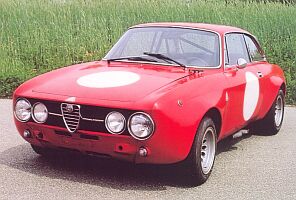 the
various Giulia GTA cars.
the
various Giulia GTA cars.
In 1967 there emerged an altogether different
car from the Autodelta workshop, the Tipo 33. A tubular chassis with fibreglass
bodywork, the first prototype was fitted with a Giulia TZ engine, but the
finished car used a 2-litre V8. None of the four cars entered in the Targa
Florio that year finished, but the development work went on and early in
1968 the cars finished first, second and third in the 2-litre class at
the Daytona 24 hour race. That proved to be the start of a successful year,
with numerous class and overall wins for the T33. This continued for the
next few years, although the competition from Porsche and Ferrari was too
fierce to allow many victories. Notable was the 1971 Targa Florio, won
by a T33 driven by Vaccarella, the first Alfa Romeo victory there since 1935.
The 33TT12 had a new tubular chassis and
a flat-twelve engine (2993cc and over 500bhp), derived from a unit built
for GP racing in 1952 (but never used), and emerged in 1973. Success proved
harder to find, but in 1974 they started to win, including outright victory
at Monza as well as some other podium finishes. In 1975 it finally paid
off with victory in the World Sports Car Championship after numerous race wins, including several one-two’s.
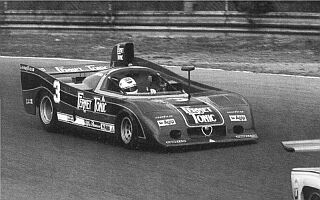 For
1976 a new variant, the 33SC12 was introduced, with a lighter and stronger
chassis. In its debut year it struggled for success, but the following
year, 1977, saw Alfa Romeo take eight victories in eight races and the
World Sports Car Championship for a second time. The cars that year included
the final development of the T33 with a 2.1-litre turbo engine with 640bhp.
For
1976 a new variant, the 33SC12 was introduced, with a lighter and stronger
chassis. In its debut year it struggled for success, but the following
year, 1977, saw Alfa Romeo take eight victories in eight races and the
World Sports Car Championship for a second time. The cars that year included
the final development of the T33 with a 2.1-litre turbo engine with 640bhp.
Whilst the T33 had been winning everything
in Sportscar racing, Alfa Romeo had taken the decision to return to GP
racing in the form of an engine supplier to the existing Brabham team.
The engine in question, a 3-litre flat-twelve with 520bhp was developed
from the T33 unit, and thus saved a large amount of investment. The Brabham
Alfa BT45 debuted in the 1976 season and was a midfield runner for most
of the year. 1977 saw an improvement with some front-row grid positions
and a few podium finishes, but victory still eluded the team. They finally
managed in 1978, helped by the arrival of Lauda. The Swedish GP saw the
debut of the ‘Fan-car’, which won the event, only to be banned from future
races. The rest of the year saw several podium finishes for both Lauda
and Watson, and another victory at the Italian GP, this time in a conventional (i.e. not 'Fan') car.
1979 saw many changes, but less success.
Unhappy with the Brabham team, Alfa Romeo developed their own car, the
Alfa 177 (with a new V12 engine) and debuted it at the Belgian GP. Later
came the 179, whilst Brabham switched back to Ford Cosworth engines. 1980
saw the 179 continuing to race, but never finding victory, a story continued
in 1981 and 82. For 1983 a new 1500cc V8 turbocharged engine was developed,
for the 183T car, but success still eluded the team. The 184T in 1984 and
1985 proved equally unsuccessful and at the end of that year Alfa Romeo
withdrew from GP racing, although they continued to supply the Osella team for some years.
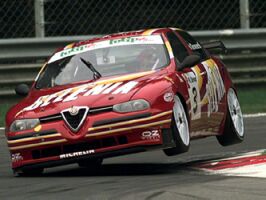 A
final attempt in GP racing was made when Alfa Romeo developed a four-cylinder
turbocharged engine for the Ligier team. Testing of the engine/chassis
combination was underway when the project was cancelled.
A
final attempt in GP racing was made when Alfa Romeo developed a four-cylinder
turbocharged engine for the Ligier team. Testing of the engine/chassis
combination was underway when the project was cancelled.
A further attempt in a similar direction
was made when Alfa Romeo developed a V8 turbocharged engine for CART. Fitted
to a March chassis they competed with little success in 1990 before fading
away. In the 1980's Alfa Romeo also made a brief foray into rallying with
the Alfetta GTV2000 Turbodelta, homologated into Group 4.
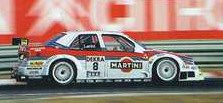
Since that time Alfa Romeo has been involved
mainly in Touring Cars, first with the 75, then with
the 155, which won almost everything in Europe (and
several other parts of the world too) from 1992 to 1995 and finally with
the 156 which continues to win to this day. Now
the 147 is also turning to competition in many countries around the world.
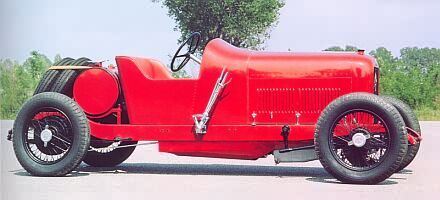 Alfa
Romeo made its first tentative steps in motorsport in 1911 when it entered
the Targa Florio with two 20/30s. Neither finished and nor did the single
example entered in 1913. In that latter year, however, a better result
was achieved in the Parma-Poggio di Berceto hillclimb with a 40/60 and
the following year saw 4.5-litre 40/60s finish second and third in the
Coppa Florio.
Alfa
Romeo made its first tentative steps in motorsport in 1911 when it entered
the Targa Florio with two 20/30s. Neither finished and nor did the single
example entered in 1913. In that latter year, however, a better result
was achieved in the Parma-Poggio di Berceto hillclimb with a 40/60 and
the following year saw 4.5-litre 40/60s finish second and third in the
Coppa Florio.
 The
RL Targa Florio was again designed by Merosi and in 1923 it came first
and second (driven by Sivocci and Ascari respectively) in the event from
which it took its name. The same year also saw the emergence of the new
P1 2-litre GP car. Also designed by Merosi just in time for the Italian
GP at Monza in September, a tragic accident in practice killed Sivocci
and caused the rest of the cars to be withdrawn. It never competed again.
The
RL Targa Florio was again designed by Merosi and in 1923 it came first
and second (driven by Sivocci and Ascari respectively) in the event from
which it took its name. The same year also saw the emergence of the new
P1 2-litre GP car. Also designed by Merosi just in time for the Italian
GP at Monza in September, a tragic accident in practice killed Sivocci
and caused the rest of the cars to be withdrawn. It never competed again.
 For
the 1924 season the new star at Alfa Romeo, Vittorio Jano from Fiat, designed
the all new P2. The engine was a supercharged 1987cc straight-eight, which
in 1924 produced 140bhp. By 1925 this went up to 155bhp whilst for the
1930 season the capacity was increased to 2007cc (by increasing the bore
slightly) and the power climbed to 175bhp. Three bodywork styles were used,
all two seaters. The original had a cowled radiator and boat-tail, two
of which were later modified by having the tail cut off and replaced by
a shallow angle spare wheel carrier. For the 1930 season three boat-tailed
cars were modified to use a plated radiator similar to the Gran Sport 1750 road car.
For
the 1924 season the new star at Alfa Romeo, Vittorio Jano from Fiat, designed
the all new P2. The engine was a supercharged 1987cc straight-eight, which
in 1924 produced 140bhp. By 1925 this went up to 155bhp whilst for the
1930 season the capacity was increased to 2007cc (by increasing the bore
slightly) and the power climbed to 175bhp. Three bodywork styles were used,
all two seaters. The original had a cowled radiator and boat-tail, two
of which were later modified by having the tail cut off and replaced by
a shallow angle spare wheel carrier. For the 1930 season three boat-tailed
cars were modified to use a plated radiator similar to the Gran Sport 1750 road car.
 Back
to 1931 again, and for the GP season Alfa developed two cars, a ‘conventional’
car using the 8C2300 engine and the Tipo A which used two 6C1750 engines
side-by-side. Following its victory in the Italian GP at Monza, the 2300
GP cars were known as he ‘Monza’. These went on to score numerous victories
over the next two years, most famously the 1932 and 1933 Targa Florio’s and the 1934 Mille Miglia.
Back
to 1931 again, and for the GP season Alfa developed two cars, a ‘conventional’
car using the 8C2300 engine and the Tipo A which used two 6C1750 engines
side-by-side. Following its victory in the Italian GP at Monza, the 2300
GP cars were known as he ‘Monza’. These went on to score numerous victories
over the next two years, most famously the 1932 and 1933 Targa Florio’s and the 1934 Mille Miglia.
 German
GPs and numerous other events that year. Unfortunately by this time Alfa
Romeo was in financial difficulties and withdrew from racing for 1933.
Unofficially entered cars still won the Mille Miglia and Le Mans, amongst others.
German
GPs and numerous other events that year. Unfortunately by this time Alfa
Romeo was in financial difficulties and withdrew from racing for 1933.
Unofficially entered cars still won the Mille Miglia and Le Mans, amongst others.
 Returning
to the road, in 1936 Alfa Romeo won the Mille Miglia with 8C2900As finishing
first, second and third. More victories that year were followed by a one-two
at the Mille Miglia in 1937, this time with 6C2300B cars. The victories
continued until the following year when the first three places in the Mille
Miglia were filled with 8C2900B cars.
Returning
to the road, in 1936 Alfa Romeo won the Mille Miglia with 8C2900As finishing
first, second and third. More victories that year were followed by a one-two
at the Mille Miglia in 1937, this time with 6C2300B cars. The victories
continued until the following year when the first three places in the Mille
Miglia were filled with 8C2900B cars.
 As
mentioned above, the Tipo 158 Alfetta was being developed at the same time,
for use in the Italian National Championship. This had a 1500 dohc straight-eight
engine, supercharged and producing 190bhp @ 7500rpm. It won its debut event
and continued to score victories as the power increased (up to 225bhp in
mid-1939), only to be stopped by the war.
As
mentioned above, the Tipo 158 Alfetta was being developed at the same time,
for use in the Italian National Championship. This had a 1500 dohc straight-eight
engine, supercharged and producing 190bhp @ 7500rpm. It won its debut event
and continued to score victories as the power increased (up to 225bhp in
mid-1939), only to be stopped by the war.
 For
1951 the Tipo 159 was developed. With 425bhp Fangio won the World Championship
with Alfa Romeo taking five race victories, followed by Ferrari with three.
Alfa Romeo then decided to withdraw from GP racing and concentrate on sports
cars. This time the withdrawal would last for over 25 years.
For
1951 the Tipo 159 was developed. With 425bhp Fangio won the World Championship
with Alfa Romeo taking five race victories, followed by Ferrari with three.
Alfa Romeo then decided to withdraw from GP racing and concentrate on sports
cars. This time the withdrawal would last for over 25 years.
 enough
to have 10 TZ2s produced in 1965 for Autodelta, the company contracted
to run the official competition cars. At the same time there appeared the
Giulia GTA and GTA corsa. Based on the Bertone designed Giulia GT the GTA
had 115bhp whilst the full-race ‘Corsa’ version had 170. 1967 saw 10 supercharged
version appear, called the GT-SA, whilst from 1968 the GTA1300, with 160bhp,
was produced. The final cars in this family were the 1750 and 2000 GTAm’s, with 220 and 240bhp respectively.
enough
to have 10 TZ2s produced in 1965 for Autodelta, the company contracted
to run the official competition cars. At the same time there appeared the
Giulia GTA and GTA corsa. Based on the Bertone designed Giulia GT the GTA
had 115bhp whilst the full-race ‘Corsa’ version had 170. 1967 saw 10 supercharged
version appear, called the GT-SA, whilst from 1968 the GTA1300, with 160bhp,
was produced. The final cars in this family were the 1750 and 2000 GTAm’s, with 220 and 240bhp respectively.
 the
various Giulia GTA cars.
the
various Giulia GTA cars.
 For
1976 a new variant, the 33SC12 was introduced, with a lighter and stronger
chassis. In its debut year it struggled for success, but the following
year, 1977, saw Alfa Romeo take eight victories in eight races and the
World Sports Car Championship for a second time. The cars that year included
the final development of the T33 with a 2.1-litre turbo engine with 640bhp.
For
1976 a new variant, the 33SC12 was introduced, with a lighter and stronger
chassis. In its debut year it struggled for success, but the following
year, 1977, saw Alfa Romeo take eight victories in eight races and the
World Sports Car Championship for a second time. The cars that year included
the final development of the T33 with a 2.1-litre turbo engine with 640bhp.
 A
final attempt in GP racing was made when Alfa Romeo developed a four-cylinder
turbocharged engine for the Ligier team. Testing of the engine/chassis
combination was underway when the project was cancelled.
A
final attempt in GP racing was made when Alfa Romeo developed a four-cylinder
turbocharged engine for the Ligier team. Testing of the engine/chassis
combination was underway when the project was cancelled.

![]() Click here for a video clip of the 155 dominating the 1993 DTM. (3.9MB)
Click here for a video clip of the 155 dominating the 1993 DTM. (3.9MB)
